This post may contain affiliate links. Please read our disclosure policy.
These stuffed cabbage rolls are filled with a hearty mixture of rice and meat, creating a wholesome and comforting dish.
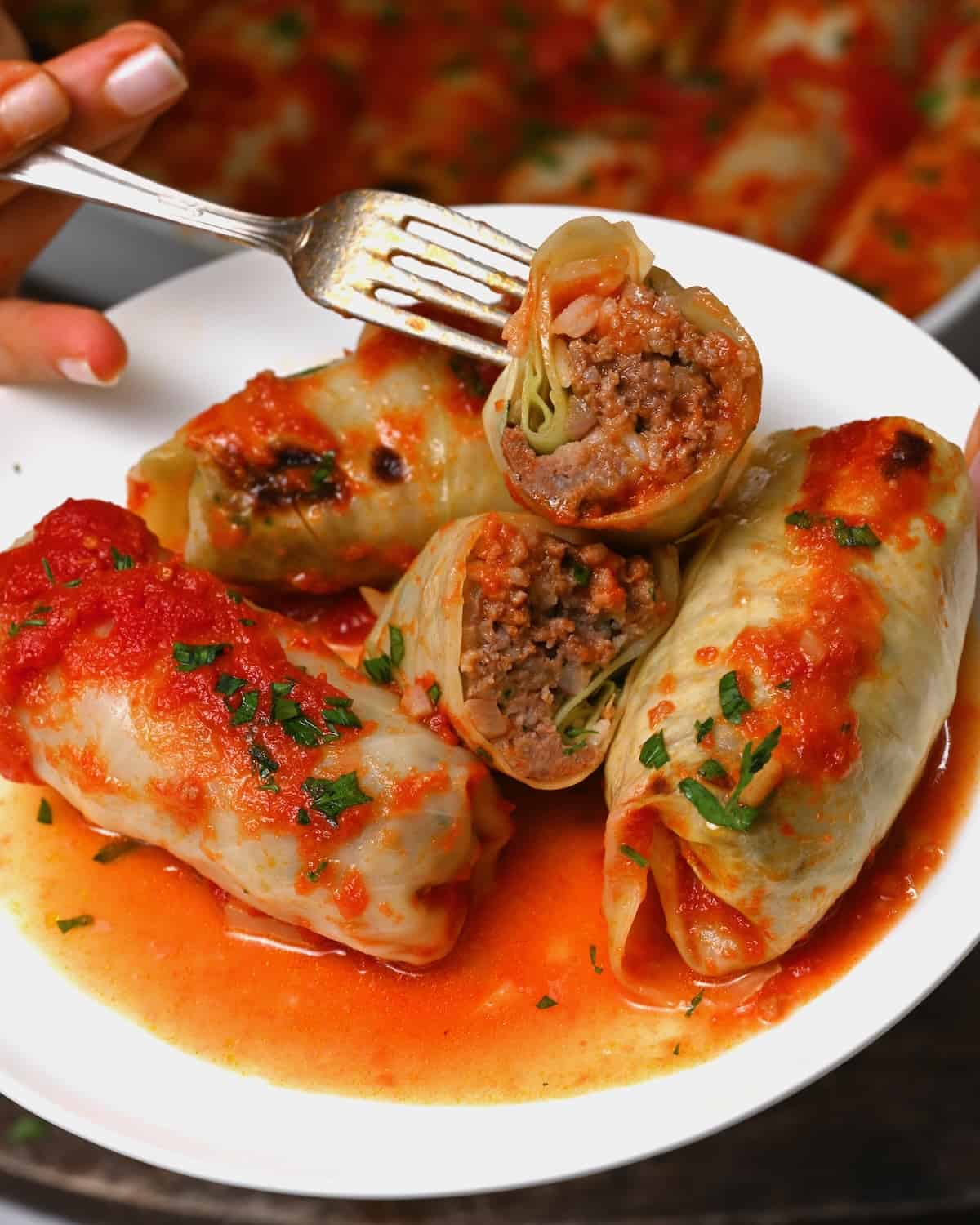
If you’ve tried or enjoyed recipes such as stuffed grape leaves and stuffed rainbow chard, let these cabbage rolls step into the spotlight. They are baked to perfection in a bed of delicious homemade tomato sauce.
Plus this recipe is so simple, requiring just a handful of common pantry staples. Whether as a low-cost appetizer, satisfying entrée, or delicious main course, these budget-friendly stuffed rolls will be everyone’s favorite.
And if you’re a fan of cabbage dishes, you’ll absolutely love the cabbage soup—it’s a comforting favorite for any winter table.
Want to save this recipe?
Watch how I make it
Ingredients
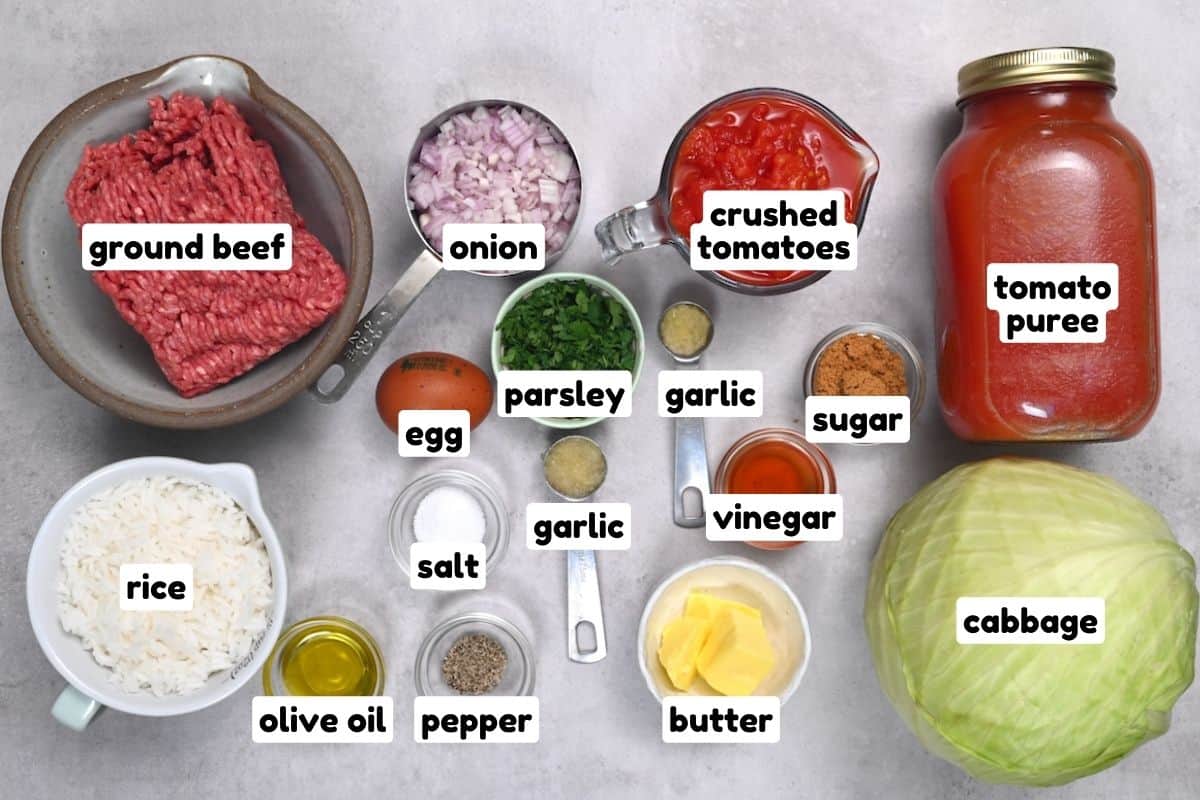
- Cabbage: You’ll need one medium-sized head of green cabbage.
- Ground beef – I used 90% lean. Alternative: Ground turkey for a leaner option or a blend of ground beef and pork for a richer flavor.
- Cooked Rice: I love using white rice but brown works too.
- Aromatics: Chopped onion and minced garlic.
- Egg: To provide moisture and bind the filling.
- Crushed tomatoes: I used a can of crushed tomatoes for the base of the flavorful sauce.
- Tomato puree: Homemade or store-bought, for richness and depth to the sauce.
- Red wine vinegar: For acidity and depth of flavor.
- Brown sugar: For a touch of sweetness to the sauce.
- Olive Oil
- Butter
- Salt and pepper
- Chopped fresh parsley leaves
How to make stuffed cabbage rolls
Cook the rice: Refer to my guide for cooking rice for the preparation instructions.
Prepare the Cabbage: Bring a large pot of water to a boil, add salt, and carefully remove the core from the cabbage head. Place the entire cabbage in boiling water with the core at the top. Cover with the lid and let simmer for 2 minutes.
After 2 minutes, carefully peel off the softened leaves one by one while the cabbage simmers. Starting from the core, use a large spoon to stabilize the cabbage in the pot, and gently pull the leaves off with tongs. Repeat for all leaves and set them aside.
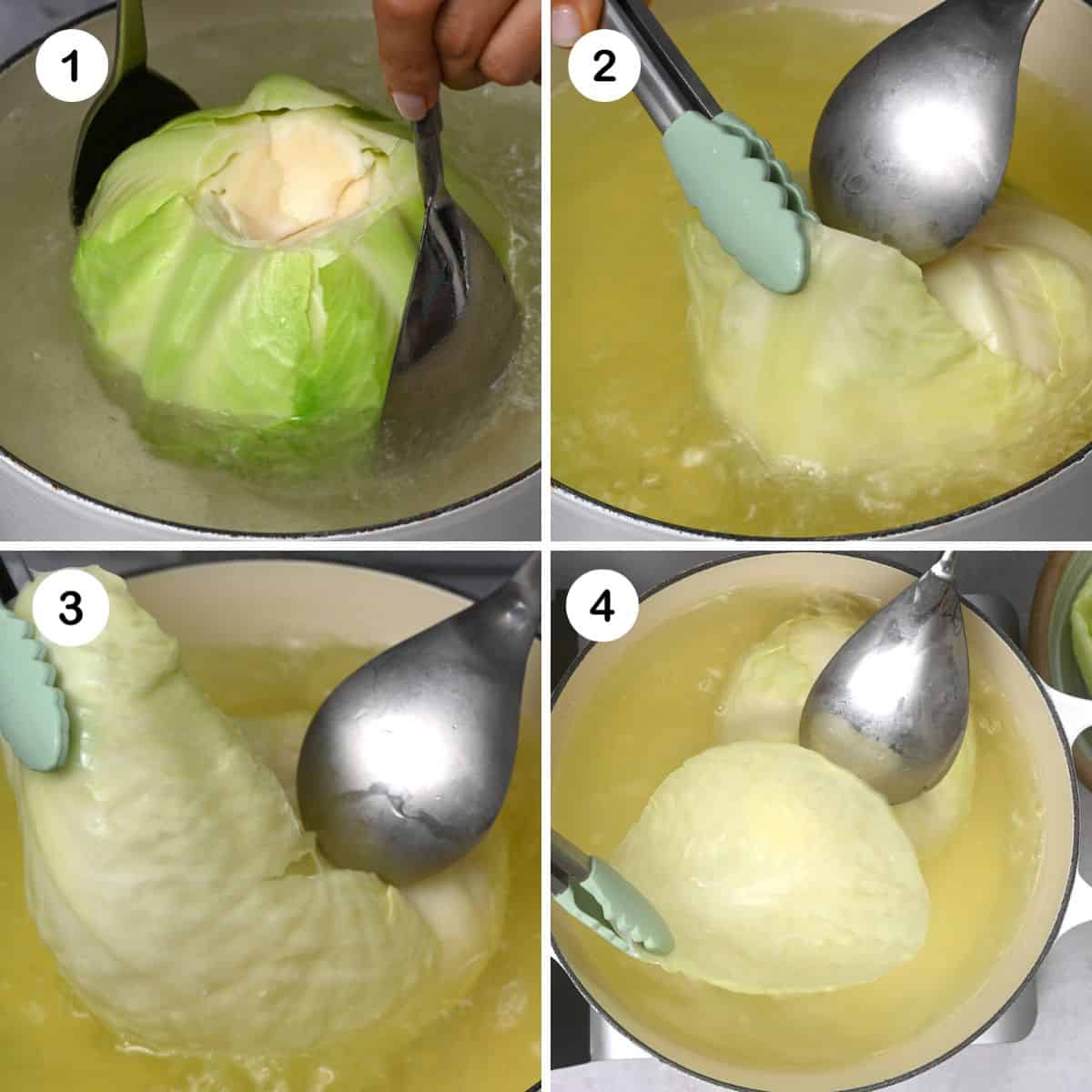
Prepare the Stuffing: In a large bowl, combine the cooked rice, ground meat, chopped onion, half of the minced garlic, egg, salt, pepper, and parsley (set some parsley aside for garnish). Mix well.
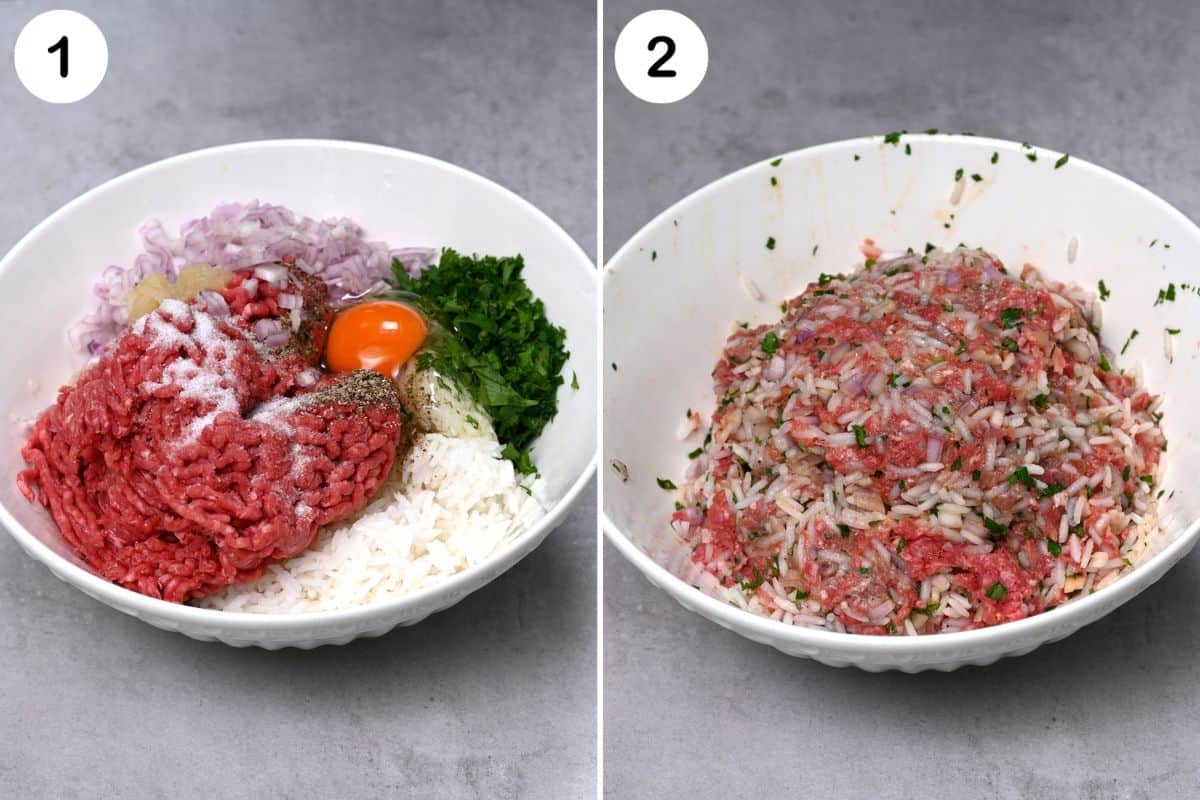
Cook the tomato sauce: Heat the butter and oil in a large pot over medium heat. Sauté the remaining minced garlic until its aroma is noticeable. Add the crushed tomatoes, tomato sauce, sugar, and red wine vinegar to the pot and simmer for 10 minutes.
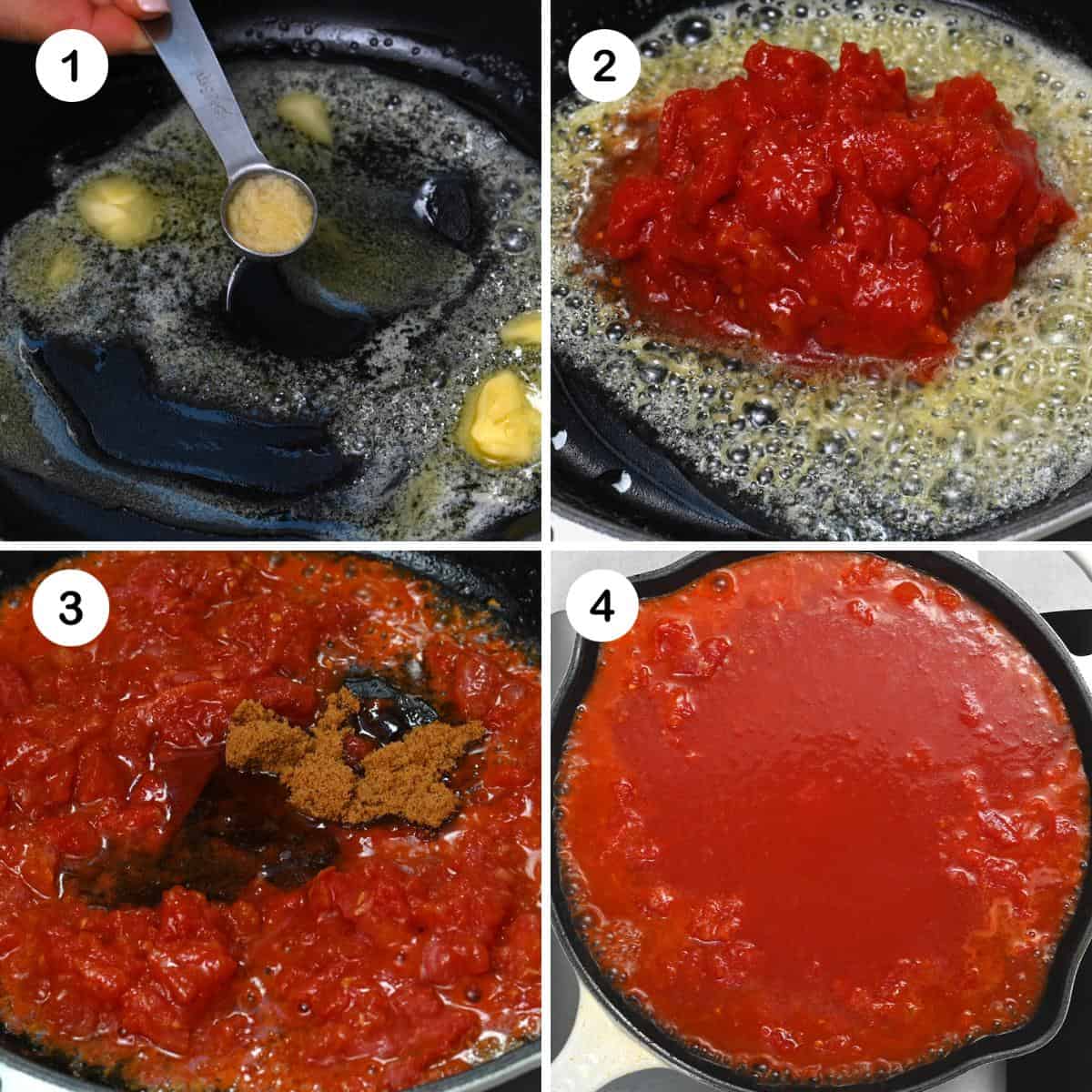
Stuff and roll the cabbage leaves: Take a cabbage leaf and trim the thick part rib to create a V shape (refer to the photos below). Place about 1/3 cup of filling in the center of the V-shaped leaf. Roll the cabbage leaf, enclosing the filling in a log shape and folding the sides inward to create a tight roll.
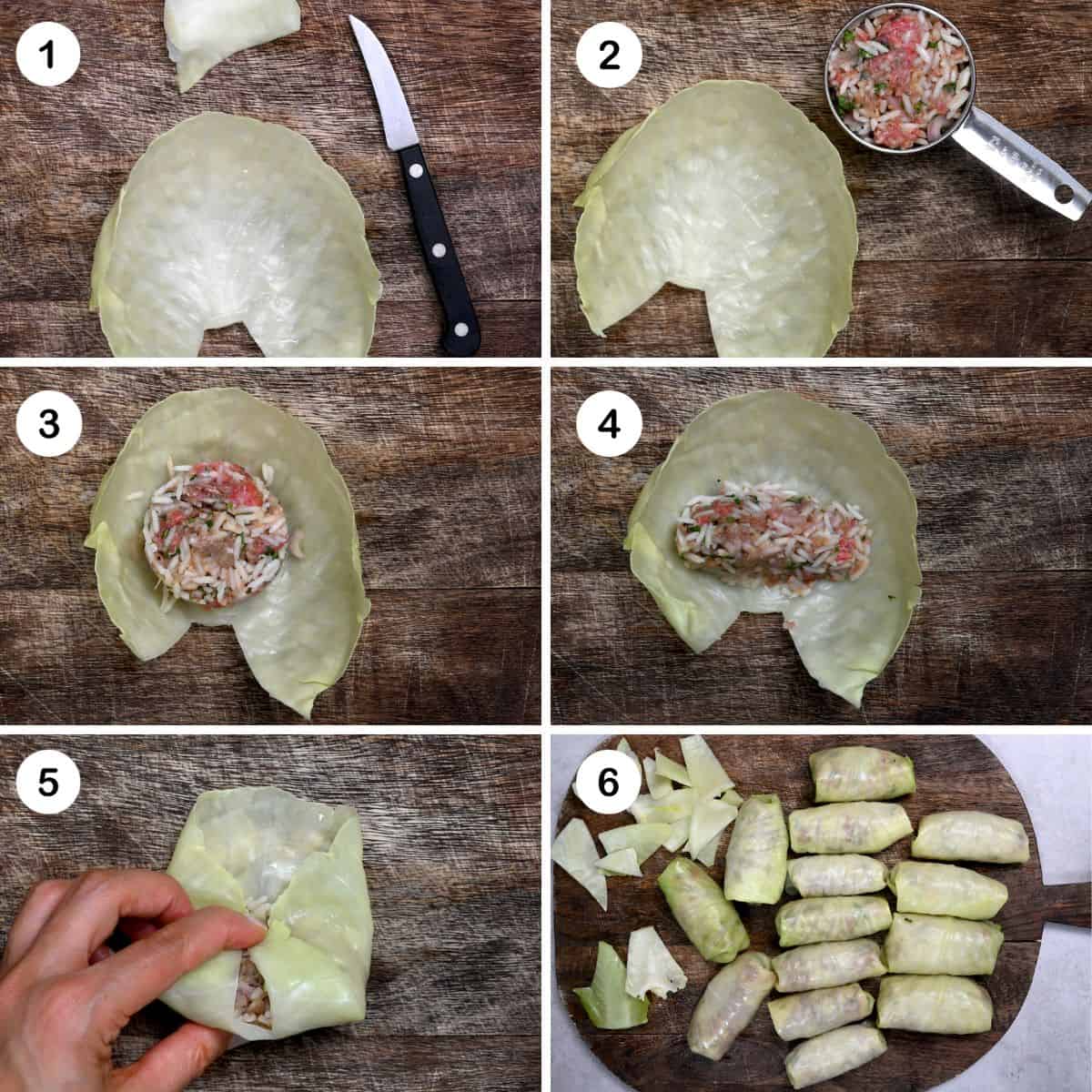
Don’t discard the cut ribs – chop them and place them at the bottom of the pan when baking the rolls.
Cook the cabbage rolls: Next, preheat the oven to 350ºF/175ºC. Then, brush the baking pan with oil, spread the chopped thick cabbage ribs on the bottom, and add half of the sauce. This layer will serve as a natural barrier between the cabbage rolls and the bottom of the pan (preventing burning).
Next, place the cabbage rolls in the pan, seam side down to secure and seal the rolls during baking. Top with the remaining sauce.
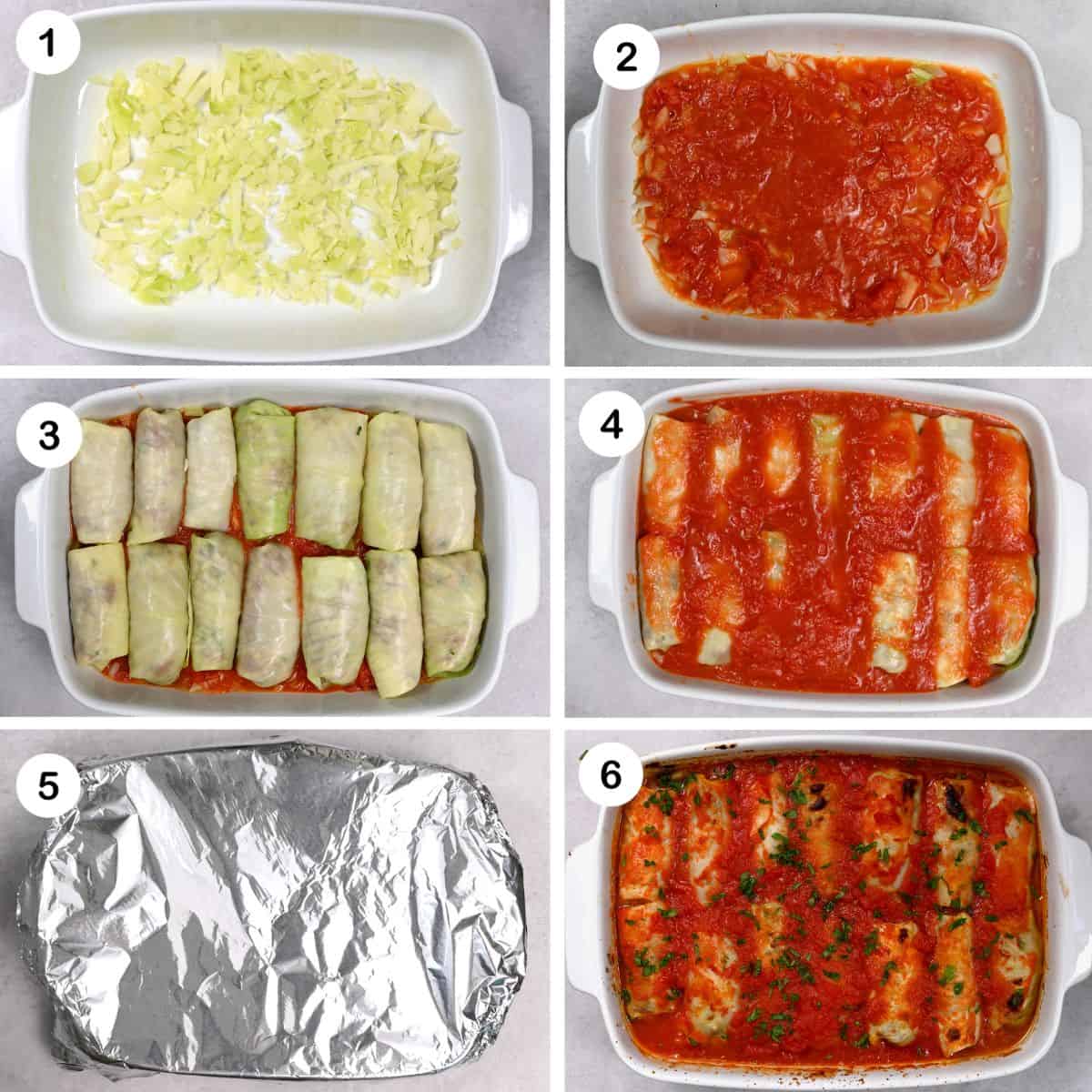
Cover the baking dish with foil and place in the oven for about 1 hour at 350ºF/175ºC. At the hour mark, check for doneness and bake for an additional 15-20 minutes or until the cabbage is tender. Adjust the total baking time based on the desired tenderness of the cabbage. Sprinkle with the remaining parsley before serving.
Tips for making stuffed cabbage rolls
- For perfect peeling, simmer the whole cabbage head with the core at the top, covering it for about 2 minutes until the leaves effortlessly separate.
- Trim the thick part of the cabbage leaves for easier rolling.
- Spread the stuffing evenly in all leaves. Don’t overstuff, so they roll and cook just right.
- Fold and roll it tightly enough from the center of the cabbage leaf so that it doesn’t unravel while cooking.
- Put cabbage rolls seam side down in the baking dish for secure baking, maintaining a tight seal during cooking.
- Never place cabbage rolls directly on the bottom of the pan. If you do, they can burn. Instead, make sure to use the thick, chopped cabbage stems or any discarded leaves as a barrier layer at the bottom of the pan.
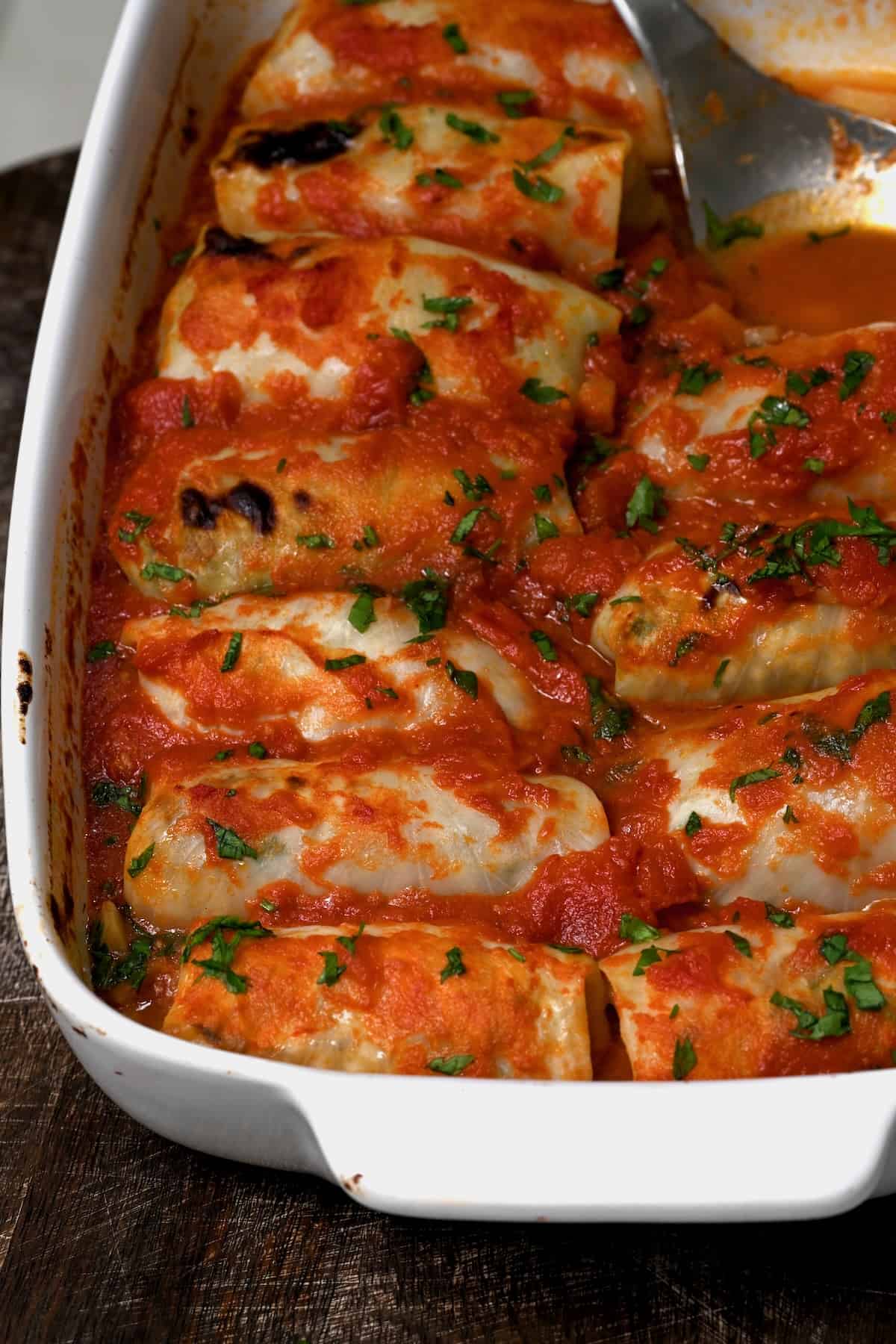
How to store
- Fridge: Place any leftover stuffed cabbage rolls in an airtight container and keep them in the refrigerator for 3-5 days.
- Freezer: For longer storage, these rolls can be frozen for up to three months. Place them in an airtight container and label before freezing.
- To make ahead: Cabbage rolls can be prepared ahead of time and stored covered in the refrigerator for up to a day before you plan to bake them.
- To reheat: Warm them in the oven at 350°F/175ºC until heated through, or microwave individual portions until thoroughly hot.
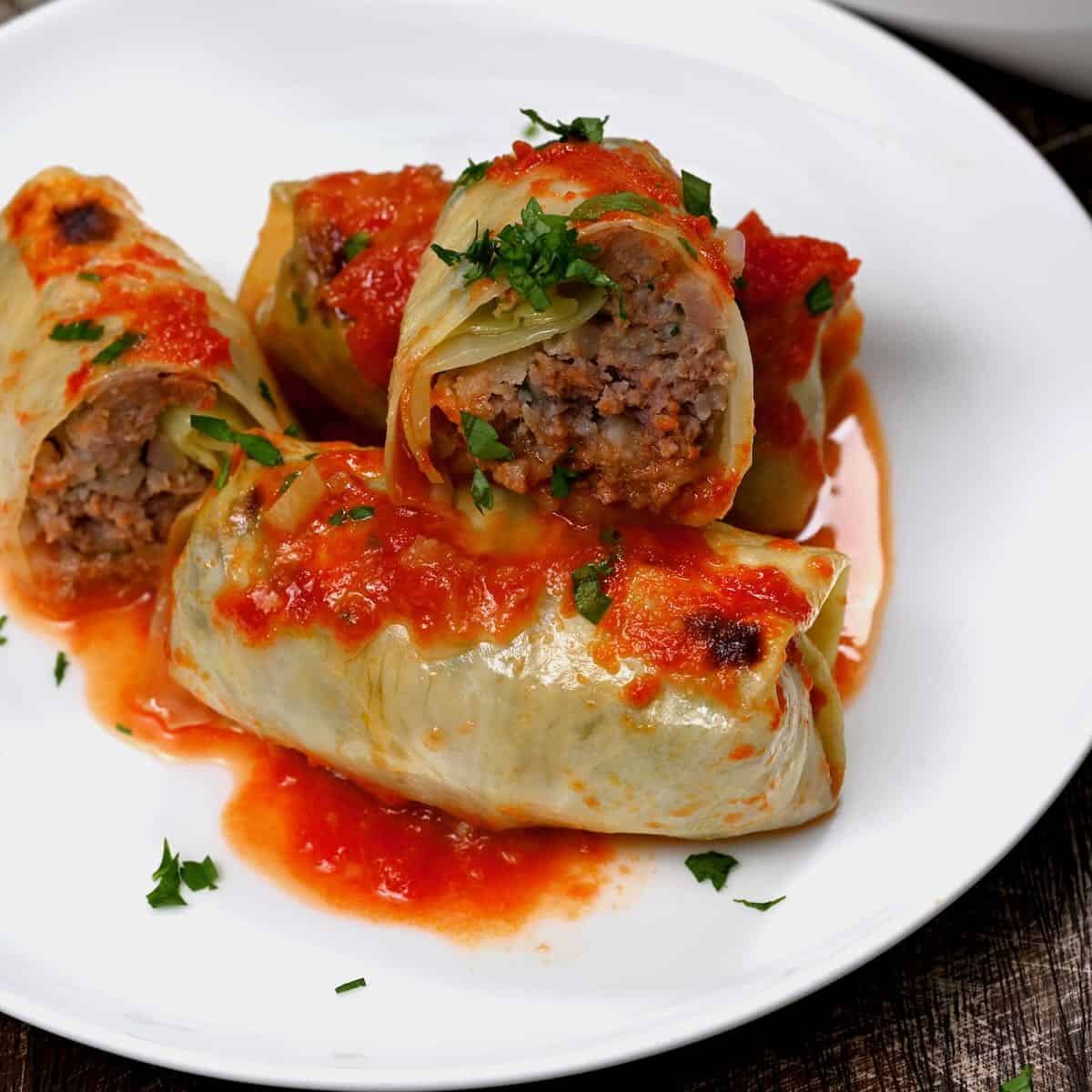
More cabbage recipes
If you try this recipe, let me know how it goes in the comments below. I’d appreciate a recipe card rating and would love to see your recipe recreations – tag me on Instagram @Alphafoodie!
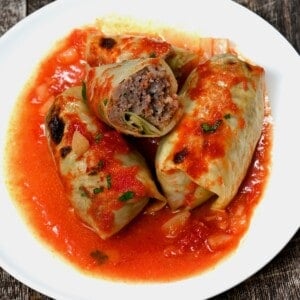
Stuffed Cabbage Rolls
Ingredients
- 2 lb cabbage (1 medium head)
- 1 lb ground beef
- 9 oz cooked rice (1.5 cups)
- 15 oz crushed tomatoes (1 can)
- 15 oz tomato puree (1 can)
- 3.3 oz onion (1 cup chopped)
- 3 cloves garlic minced (divided into 1 tsp and 1/2 tsp)
- 2 Tbsp butter
- 2 Tbsp olive oil
- 2 Tbsp red wine vinegar or apple cider vinegar
- 2 Tbsp brown sugar
- 0.3 oz parsley (1/4 cup chopped)
- 1 egg
- 1 tsp sea salt or to taste
- 1/2 tsp black pepper or to taste
Instructions
Prepare the different elements
- Cook the rice – refer to my post for cooking rice for preparation instructions.
- Carefully remove the core from the cabbage head. Discard any damaged top leaves.
- Bring a large pot of water to a boil and add salt. Place the entire cabbage in boiling water with the core at the top. Cover and simmer for 2 minutes.
- After 2 minutes, carefully peel off the softened leaves one by one while the cabbage simmers. Starting from the core, use a large spoon to stabilize the cabbage in the pot, and gently pull the leaves off with tongs. Repeat for all leaves and set them aside.
- In a large bowl, combine the cooked rice, ground meat, chopped onion, half of the minced garlic, egg, salt, pepper, and parsley (set some parsley aside for garnish). Mix well.
- Heat the butter and oil in a large pot over medium heat. Sauté the remaining minced garlic until its aroma is noticeable. Add the crushed tomatoes, tomato sauce, sugar, and red wine vinegar to the pot and simmer for 10 minutes.
Assemble and cook
- Take a cabbage leaf and trim the thick part rib to create a V shape (refer to the photos on the post). Place about 1/3 cup of filling in the center of the V-shaped leaf. Roll the cabbage leaf, enclosing the filling in a log shape and folding the sides inward to create a tight roll.Don't discard the cut ribs – chop them and place them at the bottom of the baking dish.
- Preheat the oven to 350ºF/175ºC.
- Brush the baking pan with oil, spread the chopped thick cabbage ribs on the bottom, and add half of the sauce. This layer will serve as a natural barrier between the cabbage rolls and the bottom of the pan (preventing burning).
- Place the cabbage rolls in the pan, seam side down to secure and seal the rolls during baking. Top with the remaining sauce.
- Cover the baking dish with foil and place in the oven for about 1 hour at 350ºF/175ºC. At the hour mark, check for doneness and bake for an additional 15-20 minutes or until the cabbage is tender. Adjust the total baking time based on the desired tenderness of the cabbage.Sprinkle with the remaining parsley before serving.
Video
Notes
Nutrition
Nutrition information is automatically calculated, so should only be used as an approximation.















